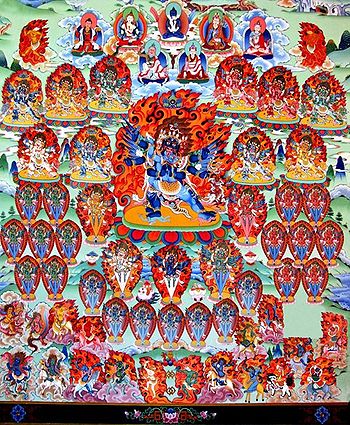Namchak Pudri

Namchak Pudri (Tib. གནམ་ལྕགས་སྤུ་གྲི་, Wyl. gnam lcags spu gri) ‘The Meteoric Iron Razor which Vanquishes Māra’ is a Vajrakilaya terma practice which was revealed by Dudjom Lingpa in 1862 from several treasure sites in Eastern Tibet. Along with the Pudri Rekpung, Namchak Pudri is one of the two main Vajrakilaya practices of the Dudjom Tersar lineage.
Content
Dudjom Rinpoche composed more than two volumes of texts for the Namchak Pudri, the whole of volumes Tha and Da of his Collected Works, as well as part of volume Za. Among all these texts are especially:
- a full Ritual Manual for the Namchak Pudri
- a Commentary on the Namchak Pudri
According to Lopön Ogyan Tanzin Rinpoche[1]:
- Out of the many wonderful traditions of Vajrakilaya, the Dudjom Namchak Pudri (The Meteoric Iron Razor which Vanquishes Māra) is one of the most extensive and profound. It carries the full consecration of the practice lineage. It is a spiritually direct revelation of special potency today. It integrates sacred words from the root Vajrakilaya tantras with key components of the principal Vajrakilaya lineages, and enlightened scholarship of the Vajrakilaya commentarial traditions’.
The Namchak Pudri contains especially elaborate teachings on the Four Phurba Transfixions (phur bu thal 'byin bzhi), which are the condensed essence of all Vajrakilaya transmissions[2]:
- The Purely Aware Primordial Wisdom Phurba (Wyl. rig pa ye shes kyi phur pa) is particularly developed in the Dzogchen section of the Namchak Pudri.
- The Compassion Emanation Phurba (Wyl. thugs rje sprul pa'i phur bu) is enlarged upon in the Ritual Manual and its long Commentary. Dudjom Rinpoche is exceptionally renowned for his expansive treatment of the kyerim in this practice.
- The Secret Bodhichitta Phurba (Wyl. gsang ba byang sems phur bu) is addressed at length in the section on the yoga of the tsa-lung, the subtle channels and energies. These three Phurba Transfixions are all focused on the Primary Ritual (stod las) for attaining Enlightenment.
- The Symbolic Material Phurbu (Wyl. mtshan ma rdzas kyi phur pa), the final Phurba Transfixion, is directed towards the liberation of hostile forces and obstacles, and is found in great detail in the Subsidiary Ritual (smad las) section of the collection.
Purpose
Dudjom Rinpoche wrote[3] in the full Ritual Manual for the Namchak Pudri:
- Vajrakilaya's supreme and common siddhis are bestowed with ease and the potency of (his) compassion is especially swift compared with other yidams. Thus, (he) is certainly the unique secret heart deity of all the accomplished vidyadharas of India and Tibet.
Lopön Ogyan Tanzin Rinpoche wrote:
- Vajrakilaya is a wrathful form of Vajrasattva, the pure vajra nature of Enlightenment. In this imagery, the compassion of the Buddhas is expressed forcefully, to eradicate in a powerful way the entrenched ignorance and emotional afflictions which cause obstacles, interfering with auspicious circumstances and preventing the dawning of realisation. Thus, the symbol of compassion is the phurba or phurbu, the ritual dagger which stabs the obstacles and hostile forces of embodied ignorance, and transmits their consciousness to the Buddha fields.”
Revelation of the Terma
In 1848, Dudjom Lingpa revealed the Zabsang Khandro Nyingtik cycle. Part of this large cycle is his Vajrakilaya practice called Tukdrub Sangwa Gyachen[4].
Later, during the 20th century, Dudjom Rinpoche (1904-1987), incarnation of Dudjom Lingpa (1835-1904) arranged the Namchak Pudri Vajrakilaya practice on the basis of the materials found in the ‘Tukdrub Sangwa Gyachen’.
According to Lopön Ogyan Tanzin Rinpoche, “Dudjom Rinpoche did intensive practices on and mastered Dudjom Lingpa's Vajrakilaya practice, the Tukdrub Sangwa Gyachen, and in the course of this, he had his own Vajrakilaya revelation, the Pudri Rekpung”.
The name ‘Namchak Putri’ is derived[5] from the Vajrakilaya revelations of Rigdzin Düddul Dorje, who is included in the Dudjom Incarnation Line.
Propagation
According to Lopön Ogyan Tanzin Rinpoche[6]:
- “Dudjom Rinpoche took on responsibilities for preserving, editing and developing the Nyingma scriptural and practice corpus of texts. This work included editing and composing fresh texts for many of the principal Vajrakilaya traditions. Thus, in compiling the Dudjom Namchak Putri and making his own contributions to it, Dudjom Rinpoche drew upon his vast enlightened scholarship and practice experience in the Vajrakilaya traditions, as well as his own wisdom, and the vision of the original Treasure revelation.”
Dudjom Rinpoche did a Vajrakilaya Namchak Pudri Gutor practice every year in Kongpo, Tibet, at his center Lama Ling.[7]. Lama Tharchin Rinpoche wrote “I remember Dudjom Rinpoche doing a Namchak Pudri Vajrakilaya Gutor every year since I was with him from the age of eight. After escaping from Tibet, we continued to do this practice at Dudjom Rinpoche’s center Duddul Raptenling in Orissa, India”.
Before his passing, Lama Tharchin Rinpoche was able to oversee an English translation of most of the Namchak Pudri practice texts, and was able to lead a Namchak Pudri Gutor practice in his center in the USA.
Texts
There are several commentaries on this cycle written by Dudjom Rinpoche, on both the higher (stod las) and the lower activities (smad las), the dzogrim and the dzogchen practices.[8]
Notes
- ↑ Khye'u-chung Lotsawa Translation and Text Production Team, 2009, founded by Lopön Ogyan Tanzin Rinpoche.
- ↑ Op. cit.
- ↑ Dudjom Rinpoche’s Collected Works, Volume Tha: p.80.
- ↑ The Tukdrub Sangwa Gyachen is included in Volume Ca of the Collected Works of Dudjom Lingpa.
- ↑ According to Khye'u-chung Lotsawa Translation and Text Production Team, 2009, founded by Lopön Ogyan Tanzin Rinpoche.
- ↑ Op. cit.
- ↑ According to a Namchak Pudri Gutor presentation text written by Lama Tharchin Rinpoche.
- ↑ Translations possibly made at Pema Osel Ling, California